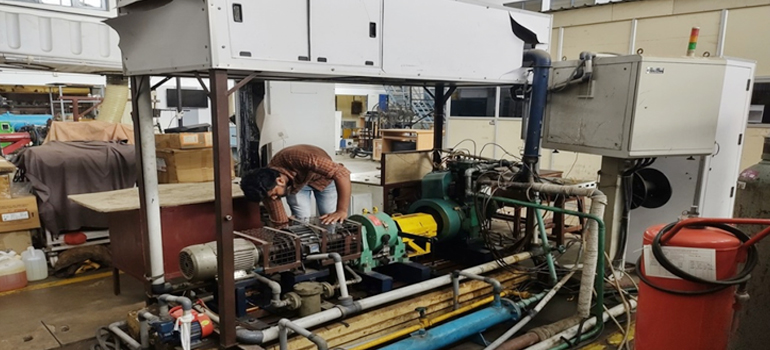
Researchers at the Indian Institute of Technology (IIT) Madras are studying mixing diesel with gasoline for better performance of diesel engines. Inside the IIT Madras Internal Combustion Engine (ICE) laboratory, this process resulted in high brake thermal efficiency and low fuel consumption, besides reducing oxides of nitrogen (NOx) and soot emissions.
In stationary applications such as water pumps and gensets as well as in heavy vehicles, diesel engines are preferred over gasoline due to their high thermal efficiency and cost-effective benefits. But the drawbacks are these emit large amounts of NOx and soot.
“The solution to addressing these drawbacks lies in low-temperature combustion engines,” Anand Krishnasamy, associate professor, Department of Mechanical Engineering, IIT Madras, told FE. “Low-temperature combustion reduces NOx and soot from diesel engines.”
How was that achieved?
A team led by Prof Krishnasamy and V Pradeep (research scholar, IIT Madras) opted for Premixed Charge Compression Ignition (PCCI)—a low-temperature combustion technique in which fuel is injected early, and a partial premixed fuel-air mixture that self-ignites is formed. This results in almost zero levels of NOx and soot. But the drawbacks were increased hydrocarbon and carbon monoxide emissions, and a narrow operating load range.
The team then mixed diesel with gasoline (70:30 ratio). Early fuel injection was timed along with exhaust gas recirculation (EGR) and water vapour induction, and this helped operate the engine over the entire load range.
How are NOx reduced?
In a conventional diesel engine, combustion happens at a high temperature of about 2,000 Kelvin, but in this method combustion happens at a lower temperature. “Onset of ignition is also delayed due to gasoline and by adding water vapour,” Prof Krishnasamy said. “Our test engine can meet any emission standards, including Bharat Stage 6.”
But while NOx and soot emissions are greatly reduced, hydrocarbon and carbon monoxide emissions are still produced. “These could be reduced by using multiple injections and optimising combustion chamber geometry. The effects of long-term use of diesel-gasoline blends need to be investigated before the commercial implementation of the proposed strategy,” he said.
Commercial applications
This method can be easily implemented in existing diesel engines.
“EGR is found in almost every modern diesel engine (without EGR, it’s difficult to meet BS6 NOx emission limits). All we need to do is inject 70:30 diesel-to-petrol blend and install water vapour induction system in an existing diesel engine,” he said.
For this tech to go from laboratory stage to product stage, Prof Krishnasamy said “if the industry reaches out to us, we can share our best practices with them.”
While there is a lot of talk about electric and hybrid, diesel has a long way to go in India, especially in heavy vehicles and stationary applications such a diesel gensets and diesel-powered water pumps. This method, he added, perfectly suits stationary applications. “Companies such as Kirloskar could be our first priority if the industry reaches out to us,” he said.
This isn’t a new method and over the decades researchers have been experimenting with blended fuels and trying to enhance efficiency of IC engines. “The breakthrough here is that we have been able to operate the engine over the entire load range,” Prof Krishnasamy said.
The findings of this research have been published in the peer-reviewed journal ‘Science Direct’.
Key findings
—Researchers used diesel with 30% gasoline by volume, and water vapour induction
—Minimal or complete elimination of after-treatment devices for controlling oxides of nitrogen and soot emissions from diesel engines
—Higher thermal efficiency is possible using the same engine geometry
—Lower carbon dioxide emissions compared to conventional diesel combustion
—This solution can be easily implemented in existing diesel engines
—Instead of vehicle engines, this tech makes more sense in diesel gensets
Original News Link
https://www.financialexpress.com/express-mobility/industry-express-mobility/diesel-catching-cold-burn-some-petrol/2690445/